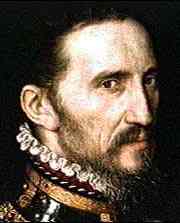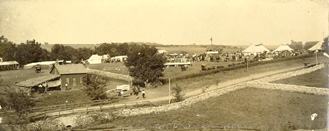About Miami County, Kansas
In the early history of Miami County, Kansas, the first inhabitants were the Indians
who established communities throughout the area. They were followed in 1541 by the Spanish
explorer, Francisco Vasquez de Coronado. The French Jesuit missionary explorers, Marquette
and Joliet, came in 1673. Next was the western expansion of the United States, with
settlers following the Santa Fe, the Oregon, or the Mormon Trails.

The Indians that have lived in Miami County are the Miamis, the Confederated Tribes,
the Pottawatomies, and the Shawnees. The Confederated Tribes were composed of the Weas,
Piankeshaws, Peorias, and Kaskaskias.
One of the first white men to come to Miami County, in 1844, was Dr. David Lykins, from
Vigo County, Indiana. He was a Baptist missionary to the Confederated Tribes.
Dr. Lykins started an Indian school one mile east of Paola in 1848. Dr. Lykins
ran his Indian school near Paola until the onset of the Civil War. His sympathies were
with the South, so he went to Colorado where he died in 1861. Other missionaries,
teachers, and traders came to Miami County; all came to aid or live among the
Indians.
Another missionary in the area was an Italian Catholic Priest by the name of Fr. Paola
Ponziglione. Fr. Ponziglione was a "horseback missionary" who rode to various Indian
settlements to preach. He eventually set up a chapel for the Indians in the Paola area.
In 1854, there began a large influx of permanent settlers who arrived to make
homes for themselves.
Kansas was admitted to the Union in 1861, and the county, originally called Lykins
County, after Dr. David Lykins, was renamed Miami County. The area played a part in
the Civil War, and names such as John Brown and William Quantrill are woven into the
county's history.

The Miami County Courthouse was built in Paola in 1898. A new county administration
building, located across the street to the east, was opened in 1998.
Paola, Kansas
Paola, in the center of Miami County, has a population of about 6,000, and is the county
seat. The town was incorporated by the Legislature in regular session on March 20, 1855.
The Paola Town Company was set up with Baptiste Peoria, Isaac Jacobs, A. M. Coffey, and
Dr. Lykins as the first members.

Baptiste Peoria, a member of the Confederated Tribes, was born about 1800 near Kaskaskia,
Illinois. He received no formal education, but was naturally gifted in languages.
In addition to English and French, he spoke a number of Indian languages, including
Shawnee, Delaware, Pottawatomie, and several of the languages of the Confederated
Tribes. For many years, he served as an interpreter, and for some time as chief. When
the tribes removed to Indian Territory, Baptiste went with them and died there in 1874.
Paola Park Square was given to the Town Company by Baptiste Peoria as he left with his
tribe for Oklahoma. The Town Company gave the Square to the city with the provision that
no building be built upon it. The gazebo located in the park has become the city's symbol.
Louisburg, Kansas
After more than a quarter century of being the sole residents of the area, Chief
Yellow Bear of the Confederated Tribes signed a treaty that transferred most of the land
to the federal government, resulting in most of the surviving members of the tribes
relocating to Indian Territory (Oklahoma).
By 1866, a settlement known as St. Louis began to form along the banks of Wea Creek. The
settlement was located between what is now North Broadway and North Metcalf, on either
side of Wea Creek.

In an effort to avoid confusion with the better-known St. Louis on the banks of the
Mississippi River, the Miami County settlement was frequently referred to as New St.
Louis or Little St. Louis, until the name was changed to Louisburg around 1871 or
1872.
Today, Louisburg has a population of about 3,000 and, among other attractions, is home to Powell
Observatory, which has the largest telescope in a five state area.
Osawatomie, Kansas
The name "Osawatomie" reflects the Native American origins of the area. It combines the names of the Osage and
Potawatomi tribes that moved into this area from Missouri in 1827. In 1837, the Potawatomi Methodist Mission
was established upon the site of the future town of Osawatomie. The mission was abandoned in 1848.
Osawatomie was founded in 1854 and settled by free-state families from New England and
the Ohio Valley. Often called the "Cradle of the Civil War," Osawatomie is home to the John Brown Historic Site.

In 1910, President Theodore "Teddy" Roosevelt gave his speech entitled, "The New
Nationalism," in Osawatomie. An excerpt, which refers to the area:
Now, with this second period of our history the name of John Brown will be forever associated;
and Kansas was the theater upon which the first act of the second of our great national life dramas was played. It was
the result of the struggle in Kansas which determined that our country should be in deed as well as in name devoted to
both union and freedom; that the great experiment of democratic government on a national scale should succeed and
not fail.
Osawatomie sites of interest such as the Adair Cabin, Old Stone Church, and First Land
Office reflect the early years of the town. The Osawatomie State Hospital has been a
leader in mental health in Kansas and the nation since 1864.

Click Here
To Learn About Membership

Home






